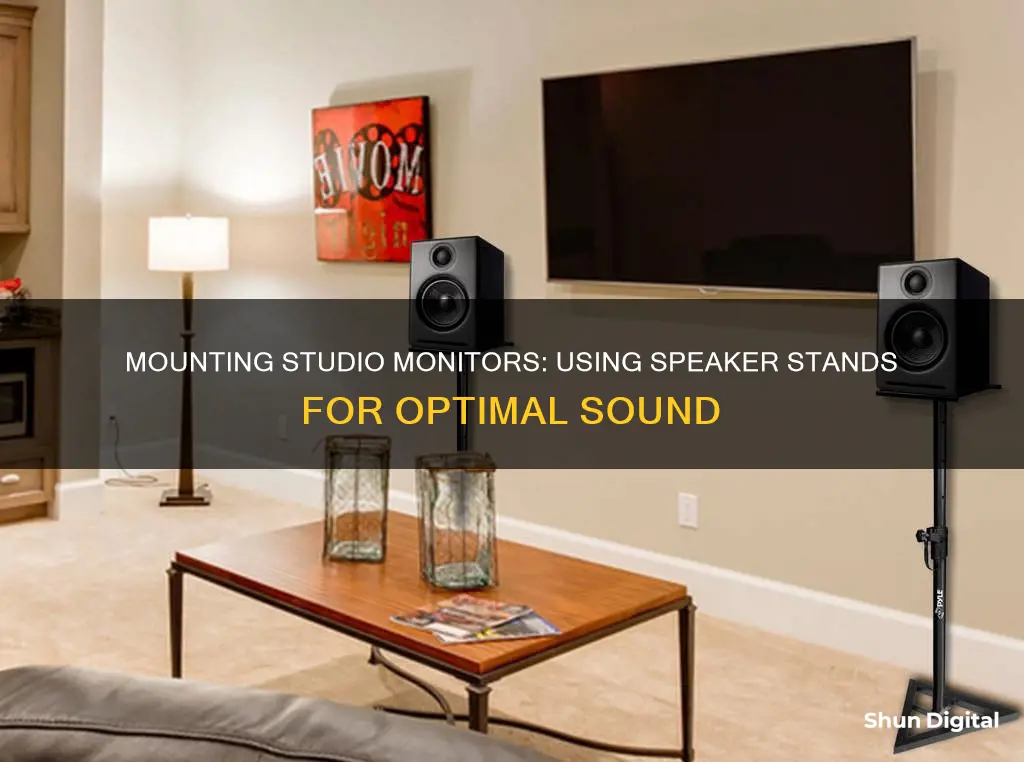
Studio monitor stands are an essential part of any recording studio setup. They provide an elevated space for your monitor speakers to sit, and they offer several benefits in terms of sound performance and practicality. The stands help to optimise the sound of your mixes by allowing flexibility in speaker positioning and reducing acoustic coupling. In addition, they free up valuable space on your desk for other equipment. When choosing studio monitor stands, it is important to consider the weight of your monitors, the desired height and angle adjustability, and the type of isolation offered. Stands come in various materials, such as metal and plastic, and can be mounted on the floor, desktop, walls, or ceiling. This guide will help you select the best studio monitor stands for your needs and provide step-by-step instructions on how to mount your studio monitors on the chosen stands or brackets.
| Characteristics | Values |
|---|---|
| Brands | On-Stage, IsoAcoustics, Behringer, Gator Frameworks, Ultimate Support, Argosy, Proline, DR Pro, Rfiver, Liquid Stands, K&M, RAB Audio, Zaor, Sound Anchors, ADAM Audio, PMC, KRK, IK Multimedia, Genelec, Ashdown, and more |
| Materials | Wood, metal, aluminium, MDF, steel, plastic, powder-coated MDF, and more |
| Type | Desktop, free-standing, floor-standing, wall-mounted, ceiling-mounted, clamp-on, tripod, adjustable, fixed, and more |
| Features | Adjustable height, adjustable angle, cable management, internal cable routing, swappable feet, isolation pads, lightweight, portable, and more |
| Compatibility | JBL, Yamaha, KRK Rokit, Bose, and more |
What You'll Learn

Studio monitor stands: types and benefits
Studio monitor stands are an essential part of any recording studio setup. They provide an elevated space for your monitor speakers to sit on, and they offer several benefits in terms of sound performance and practicality.
Types of Studio Monitor Stands
There are two main types of studio monitor stands: desktop and dedicated stands. Desktop stands sit on your desk and provide an elevated position for your speakers. Dedicated stands, on the other hand, are free-standing and allow you to decouple the speakers from your studio desk. Both types typically feature acoustic isolation, which acts as a buffer between the stand and the speaker to enhance bass reproduction and reduce vibrations at higher volumes.
Benefits of Using Studio Monitor Stands
Using studio monitor stands can provide several advantages:
- Improved sound performance: Studio monitors are designed for reference and critical listening, and by placing them at ear level, you can ensure that you're hearing the sound as it was intended. This can lead to more accurate mixes and better-balanced sounds.
- Flexibility: Monitor stands allow for much more flexibility in speaker positioning. You can adjust the height and angle of your speakers to find the perfect balance for your studio and listening position.
- Reduction of acoustic coupling: When speakers are placed on a desktop, they can vibrate certain parts of the desk, masking the actual sound of your mix. Studio monitor stands, combined with isolation pads, ensure that you hear only the sounds present in your mix.
- Practicality: Studio monitors take up valuable space on your studio desk. By using monitor stands, you free up space for other essential gear such as synths, samplers, and audio interfaces.
Setting Up Your ViewSonic Monitor: A Step-by-Step Guide
You may want to see also

Speaker position and flexibility
The flexibility of your studio monitor stands is key to optimising your studio setup. The ability to adjust the height and angle of your speakers is crucial to ensuring you're always hearing the mix in full.
If you're mixing in a studio, it's important to adjust the height of your monitors to ear level and point them slightly inward so they're facing towards your head. This will ensure you're always in the sweet spot for listening and getting great-sounding mixes.
For a live concert or outdoor festival, placing your speakers at a higher level will increase the projection of sound.
If you have a small studio and want your studio monitors out of the way, a wall- or ceiling-mounted stand is a perfect option.
If you're setting up speakers/monitors permanently, you might want to consider brackets. The On-Stage Stands Speaker Wall Mount Bracket Pair, for example, can hold up to 80 pounds and are easy to install.
When choosing stands, you'll also want to consider sturdiness and durability. Metal stands are the most popular and are durable but heavier, making them better for permanent placement. Plastic stands are more affordable, lighter, and easier to move around.
For the ultimate in flexibility, look for stands with fully flexible positioning options that allow you to tilt your monitors upward or downward and set them at the perfect height for optimal sound dispersion.
Portable Studio Monitor Stands
If you need your studio monitors to be portable, you can invest in a set of portable studio monitor stands made from lightweight materials. These stands will allow you to find your sweet spot without compromising on sturdiness.
Internal Cable Routing
Some studio monitor stands also come with internal cable routing, which can help keep your studio neat and professional-looking by concealing all the cables.
Wallpaper Setup for a Three-Monitor System: Sizing and Tips
You may want to see also

Acoustic coupling and isolation
Acoustic coupling refers to the physical connection between the speaker and its surroundings, such as a desk or the floor. When speakers are placed on a desktop, they can vibrate certain parts of the desk, depending on the frequency, masking the actual sound of the mix. This phenomenon is known as acoustic coupling.
To reduce acoustic coupling, studio monitor stands are used in conjunction with isolation pads. Isolation pads, such as those made by Auralex, are designed to physically separate the speaker from its surroundings, ensuring that the only sounds heard are those present in the mix. This can result in tighter bass and improved sound accuracy, as muddiness in lower frequencies is reduced.
However, isolation can also lead to a compromise in sound quality. Isolation pads may absorb some of the vibrations, resulting in a loss of low bass articulation, while improving the clarity of mids and highs. The type of speaker and the room's characteristics also play a role in the effectiveness of isolation. Small speakers generally work well with isolation, while larger speakers may sound better with a more rigid coupling.
In addition to isolation pads, other isolation techniques include using heavy glass or wooden surfaces to suspend the speakers above the ground or using silicone strips to decouple the speakers from the surface.
Ultimately, the decision between acoustic coupling and isolation depends on personal preference, the type of speakers, and the room's acoustics. It is essential to consider the trade-offs between tighter bass and improved mid and high frequencies when deciding on the best approach for mounting studio monitors on speaker stands.
Removing HP Compaq LA1951G Monitor from its Stand
You may want to see also

Sturdiness, weight and portability
When it comes to studio monitor stands, sturdiness, weight, and portability are key factors to consider.
Sturdiness
The sturdiness of a studio monitor stand is crucial to ensure the safety of your expensive monitors. The stand should be stable and not wobble or tip over easily. Some stands, like the On-Stage SMS6000-P, are constructed from arc-welded steel, making them extremely sturdy and capable of withstanding the occasional wobble.
Weight
The weight capacity of the stand is another important consideration. Different stands have different weight limits, so it's essential to choose one that can safely support the weight of your monitors. For example, the On-Stage SMS6000-P stands have a load capacity of 90 lbs, while the IsoAcoustics ISO-155 stands have a load capacity of 40 lbs.
Portability
If you need to move your studio monitors frequently, portability is an important factor. Some stands are designed to be easily adjustable and portable, while others are more permanent fixtures. The Ultimate Support MS-100B stands, for instance, are made of aluminium, making them lightweight and easier to transport. On the other hand, the On-Stage SMS6000-P stands are constructed from steel, making them heavier and more suitable for permanent placement.
Recognizing HD Monitors: What to Look For
You may want to see also

Placement and mounting
The placement of your studio monitors is crucial to achieving the best sound quality. When mixing in the studio, adjust the height of your monitors to ear level and angle them slightly inward so they're facing your head. This ensures you're always hearing the mix in full. For live concerts, placing your speakers higher will increase sound projection.
When it comes to mounting, you have a few options:
- Floor-standing mounts are the most common type of studio monitor stands. They offer a lot of flexibility and are perfect if you want to adjust the height and angle of your speakers.
- Wall-mounted stands are ideal if you have a small studio and want your monitors out of the way.
- Ceiling-mounted stands are another option for those looking to save space.
- Desktop stands are a good choice if you want your monitors on your desk and have limited space. They usually offer some elevation and isolation for your speakers.
- Clamp-on stands attach directly to your desk, saving valuable space.
When choosing a stand, consider the weight of your monitors and the amount of adjustment required. Some stands also offer internal cable routing to keep your studio tidy.
Additionally, isolation is an important feature of studio monitor stands. It separates the speaker from the surface it's mounted on, reducing vibrations and improving sound reproduction, especially for bass frequencies.
Best Places to Buy In-Ear Monitors on a Budget
You may want to see also
Frequently asked questions
Studio monitor stands provide an elevated space for your monitor speakers to sit on, improving sound performance and practicality. They enhance bass reproduction and reduce vibrations at higher listening volumes. They also free up space on your desk for other equipment.
There are desktop studio monitor stands that sit on your desk and free-standing dedicated stands that allow you to decouple the speakers from your studio desk.
Ensure the stands are sturdy and not likely to wobble. Look for stands that allow you to adjust the height and angle of the speakers so you can find the perfect balance for your studio and listening position.
Acoustic coupling occurs when speakers placed on a desktop vibrate certain parts of the desk, depending on the frequency, masking the actual sound of your mix. Studio monitor stands, combined with isolation pads, ensure that the only sounds you hear are those present in your mix.
When mixing in the studio, adjust the height of your monitors to ear level and point them slightly inward so they're facing towards your head. For a live concert, placing your speakers at a higher level will increase sound projection.







